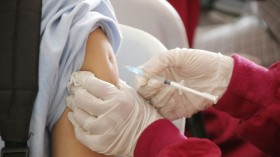Nanorockets have been making waves since they have been discovered to be ideal vessels for delivering medicine. Developed by the bio-organic chemists at Radboud University, the soft nanosystems can self-assemble and spontaneously form functional units, allowing them to change and contain substances such as medicine.
"Our biggest challenge is to provide our nanorockets with various functionalities," stated Daniela Wilson, head of Radboud University's bio-organic chemistry department and nanomedicine theme leader. "We now demonstrate the first molecularly built brake system, enabling the rockets to start and stop at desired locations."
A breakthrough made by Wilson and he
r team is the inclusion of temperature responsive brakes that are made of polymers. Shaped like brushes, these chains of responsive units grow on the surface of the nanorockets and swell or collapse in response to the environmental temperature and in this way controls fuel access to the rocket. In the case of Wilson's research, they utilized H2O2 or hydrogen peroxide.
With a high sensitivity, the brushes instantly collapse upon reaching a temperature of 35 degrees Celsius or higher, causing the machine to stop. "This all happens without affecting the catalytic activity or the shape of the nanorocket," explains Wilson. "Therefore, nanorockets equipped with this valve system are able to move with great efficiency in water, even at low concentrations of fuel."
Wilson and her team published another nanorocket finding in Advanced Materials, this time highlighting the low magnetic field that performs the function of a steering wheel. By growing magnetic metallic nickel into the core of the rockets, the magnetic field can be used to guide and steer the rockets into desired directions.
Despite the advances they have made, Wilson believes there's always room for improvement. "What would be even more interesting than temperature responsive brakes, is a system that responds to light. This would allow us to start or stop a nanorocket by shining a laser light on it. Furthermore, even though our nanorockets are not toxic to living cells, they are not completely biodegradable yet. And of course, that is one of the prerequisites for their use as medicine carriers in the body. These are only some examples of the next challenges for our group!"
© 2024 NatureWorldNews.com All rights reserved. Do not reproduce without permission.





